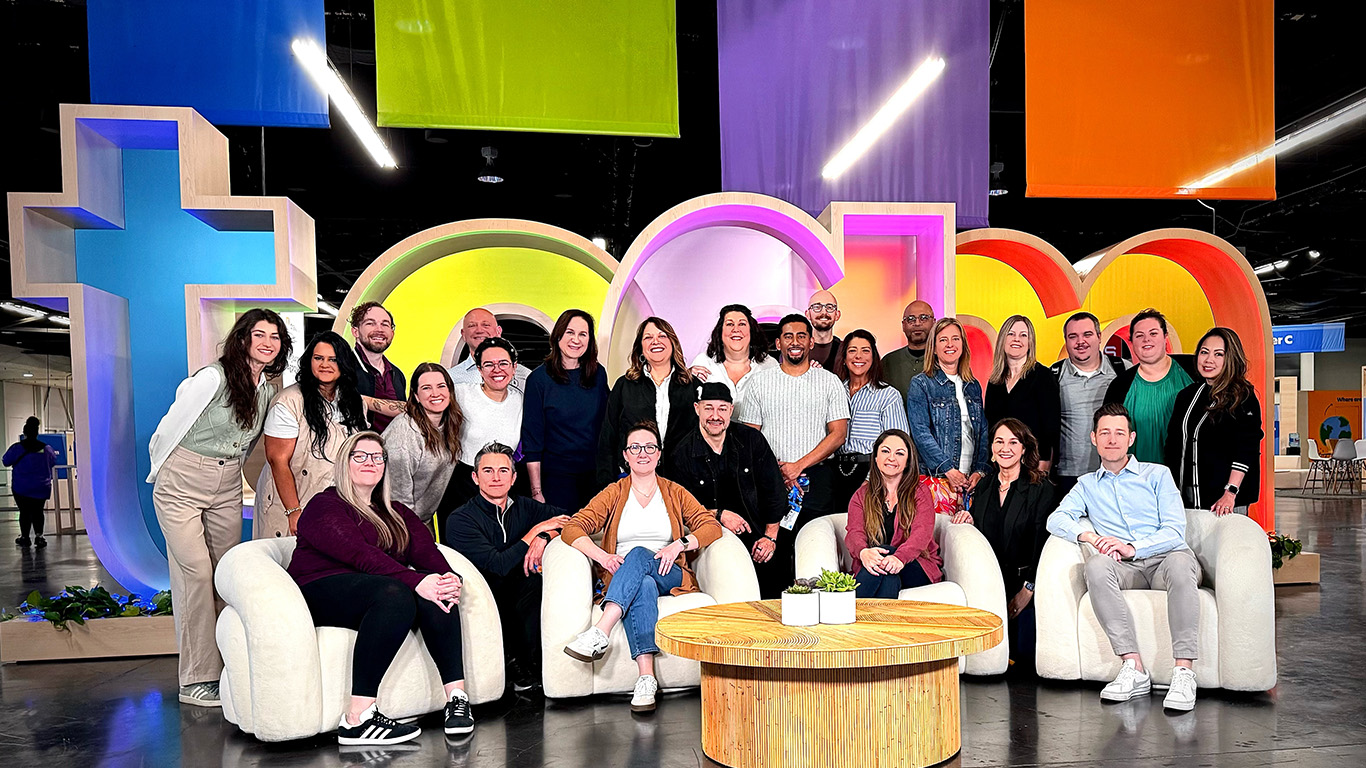One Content Strategist’s Top 7 Takeaways from Adobe MAX 2019
One Content Strategist’s Top 7 Takeaways from Adobe MAX 2019

Earlier this month, Adobe convened its annual “creativity conference,” Adobe MAX, in the heart of downtown Los Angeles.
After more than 17 years working in the creative and marketing fields – and five-plus in the event business specifically – I’d long had MAX on my radar, but this was the first year I was fortunate enough to attend. Full of anticipation for an immersive and thought-provoking conference experience, I boarded my flight to LAX.
MAX did not disappoint.
Adobe, as a company, is obviously in the business of creating cohesive customer experiences, and MAX is an opportunity to flex some of that hard-earned muscle. From the website design and tone, through registration communications, to the mobile app, until ultimately arriving onsite, the experience was consistent, intuitive, and well thought-out. Having pre-defined (or at least, pre-recommended) tracks based on role, in order to help attendees focus on the most relevant content and sessions, is nowadays de rigueur. But MAX – with 300+ sessions, labs, and creativity workshops to choose from – does a particularly effective job of letting attendees avoid getting overwhelmed and quickly zero in on the options of greatest interest. One click for “Business Strategist” as audience type, two clicks for “Inspiration” and “Thought Leadership” content categories, and I was off to the races planning my time onsite.
Over the course of those three days, a number of themes emerged across the keynotes, breakouts, creative super sessions, and evening events I attended. Obviously, this is just one person’s perspective and is based on self-selecting into an experience track specifically tailored to my interests. Here’s what resonated, in no particular order:
1. Find your tribe.
Working in the events industry, I’m no stranger to time onsite at massive conference experiences not unlike MAX. But, given Opus Agency’s client base, these are typically in the cloud computing tech space. I’m thrilled that Opus and our clients are able to deliver effective, resonant experiences for these audiences – but their interests and the related content are much more technical than what’s generally in my wheelhouse.
Being at MAX, however, I can’t overstate how inspiring it was to be immersed in an experience with 15,000 of my closest, similarly creative-industry-minded friends. The shared successes and challenges were validating, the conversations were engaging, and it further helped me understand what it takes to have your attendees walking around with smiles on their faces.
2. While creativity is limited only by our thinking, time remains the most precious and finite resource.
This was a recurrent theme throughout the conference and clearly an area of focus for Adobe – their stated goal is to remove impediments to production for creative professionals. This was such a simple, deceptively profound observation; how much time do all of us spend on work that pulls us away from where we’re operating within our strengths and delivering the most value?
In Adobe’s case, its efforts are primarily focused on removing friction from creative and design professionals’ production tasks – rendering, version tracking and file maintenance, automating tasks, etc. In the churn of daily life, especially in the at-times hectic creative and agency space, it’s more important than ever to not simply react to the fire of the day (hour?), but also to ensure you’re setting aside time to really think – slowly, strategically, and creatively. Easier said than done, I realize, but I left MAX with renewed desire to do so.
3. Too often, we tie our personal value and our sense of self-esteem to our productivity – stop it!
In a hilarious, high-energy, and wide-ranging session, artist and author Adam J. Kurtz (of Things Are What You Make of Them fame) focused much of his talk on the creators’ challenge of doing good work while not falling prey to the trap of defining your worth by the amount of it you’re able to churn out. Use what you’ve got, give yourself permission to be yourself, and say what you believe – not just what’s in the brief. In any client/creative relationship, there’s often an inherent tension between delivering the best work possible – the work you really believe in – and the potential for conflict arising as a result. But you have to speak your truth. (Knowing that some people won’t like it. And you know what? That’s okay.)
4. You simply don’t have time to be anyone but yourself. Attempting anything else is just wasted energy.
Encapsulating common themes from theme numbers two and three above, London-born and New York-based artist Shantell Martin delivered a moving keynote talk on the nature of creativity itself. Martin’s signature, deceptively straightforward line drawings, per her website, explore “themes of intersectionality, identity and play.” Her talk explored these themes in depth by way of an organic autobiography – she shuffled her stack of cue cards, each with a prompt about a time in her life, before and during her talk.
Ultimately, her theme aligned with a broader message from the event. Namely, in a culture with a sometimes misguided affection for the value of “faking it ‘til you make it,” just. Be. Your. SELF. It’s the only thing that will ultimately set you apart and help you find your true creative calling. Again, I was reminded that this seemingly simple, perhaps even easily dismissed, thought – be yourself, do the best work you know how, and quit sweating everything else – remains a valuable one to remember, no matter how much success you’ve achieved.

5. Inspiration can come from solitude… which is increasingly hard to come by.
Visionary photographer David LaChapelle believes that we all have the creative answers we’re looking for within us, if we could only find the time and the quiet space to hear them. As a teenager in the East Village during the early days of the AIDS epidemic, he became interested in the metaphysical and “photographing the unphotographable.” And while he acknowledged that inspiration can and does come from pain and loss, he also addressed the need for the increasingly rare commodity of solitude.
Especially in a creative field, where it’s our mission to deliver strategic thinking on behalf of our clients, this is essential to remember. Proactively set aside time to simply be alone with your thoughts. Make that space away from the churn, give yourself permission to turn off email in order to focus, and let your brain breathe a little in order to deliver the best possible work. Your clients will thank you, even if it took an extra 20 minutes to respond to their email.
6. Design can be a transformational force for business and culture.
In perhaps my favorite breakout session at this year’s MAX, R/GA Vice President & Executive Creative Director (and kinda-sorta Rob Thomas lookalike; sorry, Mike) Mike Rigby argued that the problem with design was that it became too small. In much of his work, he and his team have been focused on thinking bigger; humanity- vs. human-centered design, if you will.
One powerful example dealt with tackling sustainability in the fashion industry – a leading producer of the microplastics which eventually end up in the ocean (and elsewhere in our environment, food supply, etc.) The challenge is an arguably existential one, and it’s twofold: Both the problem and potential solutions are largely invisible to consumers. The answer? Evolved by Nature, a fascinating campaign built around a genuinely groundbreaking but inarguably esoteric chemical advancement, from two biotechnology engineering and biomedical engineering PhDs, called ACTIVATED SILK™. The resulting campaign leveraged message modularity, story system thinking, and simply being unafraid of using language within your brand to affect positive, scalable change. As a writer at heart, I was predisposed to love this idea: Sometimes, it’s okay to let the copy do the work, especially when it’s based in strategic thinking and seeks to make the complex simple.
7. Think of your work in terms of two columns: the creator column and the reception column. And remember, you can only control one of them. (Guess which one.)
A highlight of the event was hearing from Hollywood feature film director M. Night Shyamalan. A dynamic, articulate, and passionate presenter, he had me on the edge of my seat with each nugget of wisdom – so much so that I forgot to take notes, and this addition to the list is the one most based on memory! But I’ll forever take with me his guiding principle: There are two columns, or areas of focus, when you’re doing creative work. You can focus on the creating, or you can focus on how the work will be received. And as soon as you find yourself operating in that second column, you’ve already lost.
In his case, that means not worrying about how his films will be reviewed or what kind of box office they earn. But the concept applies to strategic creative work, as well. It can be all too easy, when doing the work, to have the question “but what will the client say?” informing every decision along the way. Ultimately, we’re all responsible for setting our clients up for success, but that doesn’t always correlate with delivering work that doesn’t push their comfort zone or challenge their assumptions. Shyamalan advised he’d once told a group of students “the secret to my success is that I’m more willing to be me than others are to be themselves.” I think we’d all do well to tack that one up above our desks.
Cheeky bonus item #8: Vampire Weekend puts on a surprisingly kickass show.
No big strategic or creative insights here. But, look. In a world where the conference-closing party headliner is oftentimes a teenage Danish DJ or whatever (not that there’s anything wrong with that!), it was a real treat to get the chance to see Vampire Weekend do their thing at the MAX Bash on the last night of the event. Don’t let the Paul Simon-y vibes of their music fool you – those artsy hipsters can shred.
More Like This, Delivered to You
As our agency continues to explore the future of experiences, you can join us and leaders from Google, Microsoft, Salesforce, and many more of our clients to stay ahead of what’s next by subscribing to XO. Each month, you’ll receive our latest insights and perspectives, plus carefully curated links worthy of your next new tab.
Insights in
the Inbox
XO is a newsletter with a mission to be loved by marketing executives and event professionals.
Through careful curation and purposeful prose, XO serves thousands of leaders who want to stay on top of what’s new and what’s next in the world of experiences.
To join in, see past issues or subscribe below.


